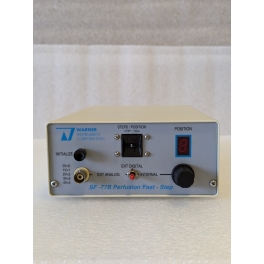WARNER SF-77B PERFUSION FAST STEP CONTROLLER
The SF-77B is a fast solution delivery device for use in patch clamp and electrophysiology studies. Control and test solutions flow continuously through adjacent delivery tubes and a stepper mechanism selects which tube is directed at the preparation.
The rapid response and nominal hysteresis of the stepper allows for very short switching times. Complete solution changes are typically achieved within 20 msec for a large, 700 µm step and times are significantly shortened as the step size is decreased.
Descriptions;
The design of the SF-77B permits the use of various size glass tubing for
perfusion delivery.
SF-77B: Standard System (0.7 mm ID tubes) The standard system is shipped with 3SG700-5 single-walled 3-barrel
glass tubing which eliminates the need to glue individual barrels together.Spacing between barrels is 0.7 mm and step speed between adjacent barrels is typically 20 msec. Single barrel SG800-5 tubes (up to 5) can be used with the same holder.
SF-77BLT: Large Tube System (1.0 mm ID tubes)
Larger ports are required when using the SF-77B with larger cell structures such as the Xenopus oocyte. Solutions are delivered through 1.0 mm ID square tubes (SG1000-5) with barrel-to-barrel spacing of 1.4 mm.
SF-77B/5M: Standard System with Five Manifolds
The SF-77B/5M is the same system as the SF-77B except that it is provided with five perfusion manifolds.
SF-77BST: Fast Stepping with Theta Tubing Very fast perfusion stepping is possible using 2-barrel Theta tubing. The technique requires close attention to detail with careful placing of the pipes and the excised patch. The tubing is pulled on a standard puller for a tip diameter of approximately 300 µm and a barrel spacing of approximately 100 µm. When using 100 µm steps, it is important to minimize any vibration produced by the stepper motor. This is accomplished by reducing the motor voltage via the control located on the instrument
rear panel. The voltage is lowered until the vibration artifact is minimized.
Manual or External Control
The stepper mechanism can be manually controlled via the front panel or externally directed from your data acquisition program. Manually, the system can be stepped to 8 positions in 7 equally spaced steps. These same 8 positions can also be directly selected by applying an analog signal to the external analog input BNC or by passing a 3 byte word to
the TTL input on the instrument rear panel.
Square Glass Ports
The square glass tubes used for solution delivery significantly reduces mixing turbulence, allowing the SF-77B to be used for studies with both membrane patches and whole cells, even when the cells are not fixed to a substrate.
Easy Set-Up
The stepper mechanism is compact, lightweight, and free of either mechanical or electrical noise. The mechanism connects to the control box with a 2 meter shielded cable and is provided with a mounting rod for attachment to a manipulator. Manifolds can support 2, 4 or 6 inputs depending on the experiment. Solutions flow from reservoirs to the manifold through PE-50 tubing and PE-10 tubing is used to connect the manifold outputs to the glass tubes.
• Solution changes between tubes occur within milliseconds.
• Changes between solutions connected to individual ports occur
within 5 seconds.
• Entirely new solutions can be added into any port with a waiting
time of no more than 30 seconds.
• The cell is never required to pass through an intervening solution
to get from control to test solution.
Specification;
Number of Steps: 1 to 7 selectable
Step Size: Adjustable from 100 µm to 1.5 mm steps in 100 µm increments
Step Speed: 20 msec for 700 µm step
Step Control: Manual 8 positions with POSITION selector
Analog Signal 8 positions with voltage levels 0-7 V, 1V/step
Digital Signal 8 positions with 3 byte TTL signal
Maximum Stepper Range: 12.0 mm
Solution Manifolds: MM series for SF-77B and SF-77BST and ML series with SF-77 BLT
MM Series Manifolds use PE-50 tubing at input and PE-10 tubing at output
Solution Flow Rates: Rates measured with solution reservoir height of approx. 60 cm (24 in) With MM Series 100 µl/min
Manual or automatic step control (digital or analog) 1step = 100 µm
Number of step: 15
- No switching through intervening solutions.
- Number of Positions: 8
APPLICATION
- Electrophysiology research for controlling extracellular fluid environments.
- Solution delivery for patch clamp and other electrophysiology studies
- Solution changes in milliseconds
- Minimal flow turbulence
- Cell and tissue culture to maintain proper conditions and stimulate specific cellular responses.
- Pharmacology and drug testing to apply drugs and other reagents at controlled rates.
- Neurobiology to study brain tissue and neuronal signaling under controlled conditions.
- Multifunctional fluid delivery in systems requiring rapid solution switching.
- In vivo and in vitro perfusion studies to mimic physiological conditions.
- Educational tool for training students in laboratory techniques and perfusion systems
 Maximize
Maximize

 NeuroLabParts provided us with great quality second hand Patch clamp equipment. The prices were very affordable and the items were almost brand new. Their customer service, maintenance and warranty services were GREAT and they helped us a lot in setting up our lab.
They would even follow up with us for updates on the performance of equipment and are always ......
NeuroLabParts provided us with great quality second hand Patch clamp equipment. The prices were very affordable and the items were almost brand new. Their customer service, maintenance and warranty services were GREAT and they helped us a lot in setting up our lab.
They would even follow up with us for updates on the performance of equipment and are always ......














Follow us